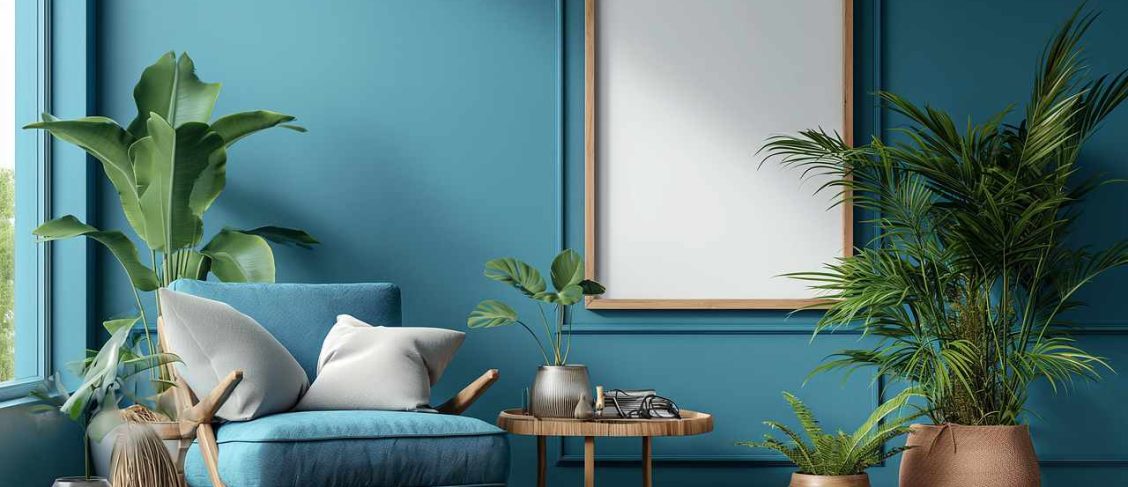Have you ever felt tired just walking into a room, or had trouble focusing because everything around you seemed to be a mess? We all know how important it is to take care of our minds and bodies, but how often do we think about the places we spend time? The way your space is designed is very important to your health, whether you’re working from home, spending time with family, or just looking for a quiet place to relax. We often feel stressed and overwhelmed in our busy world, so it’s easy to forget that the space around us can either make us feel more energized or more tired.
Wellness interior design is more important than ever because it’s all about making spaces that are good for your physical, mental, and social health. But how can you make your home or office a place where you can relax and feel good? Let’s look at six important rules that will help you create a wellness-centered space that makes you feel good, motivated, and relaxed.
1. Being Aware of How the Environment Affects Health
The Link Between Mind, Body, and Design
There are times when you walk into a room and right away feel calm or tense. There is no doubt that our surroundings affect our health. Our mental health, mood, and even physical health are affected by the places we live. Imagine living in a room that is a mess with piles of things all over the place. It’s simple to feel thrown off or stressed. On the other hand, places that are carefully planned to be balanced and harmonious can make people feel calm and happy. Things like lighting, color choices, and even the way furniture is arranged can change how we feel. Blues and greens, for example, can help you relax, while too much bright white light or patterns that are all over the place can make you feel stressed and irritable.
Problems People Face
A lot of us have trouble with being too stimulated in the places where we live or work. The modern way of life often causes people to accumulate clutter, like papers, tools, or decorations that aren’t needed, which can be overwhelming to look at. As a result? More stress and trouble concentrating. Another common problem is bad air quality, which can be caused by dust, pollution, or not enough airflow. This is not only bad for your health, but it can also make it hard to focus, sleep, or even relax.
Solutions for Improvement
Improving the way your room is laid out is a good place to start. Getting rid of clutter, putting away fewer things, and setting things up in a way that’s easy to keep up can help you feel a lot less stressed. You don’t have to get rid of everything, but finding useful ways to store things and using fewer artistic items can help you feel better. When choosing colors for your room, choose soft blues, greens, and neutral earth tones that make you feel calm. Plants and wooden furniture are also natural things that can make a room feel grounded and warm.
2. Using Natural Elements Together
The Benefits of Nature in Interior Design
It’s no secret that being in nature makes us feel better. Adding natural features like plants, water, and natural light through biophilic design can make any room feel like a sanctuary. This is especially true when paired with a comfy minimalist living room with plants where greenery becomes part of the aesthetic rather than an afterthought. Studies have shown that spending time in nature can lower stress, improve your happiness, and even make you more productive.
Studies have shown that spending time in nature can lower stress, improve your happiness, and even make you more productive. Imagine having a small indoor garden with lots of lush plants or a water feature that makes nice sounds. Also, natural light changes things. It has been shown that being outside in the daylight can help your happiness and sleep. Being near trees or being able to get fresh air can help your mind and body feel better.
Problems People Face
Many people who live in cities may not have easy access to nature. Lack of outdoor space, tall buildings, and small apartments can make people feel cut off from nature. The same goes for air that doesn’t flow well, which can make you feel hot and uncomfortable. Our health and happiness can suffer if we don’t get enough sunshine or fresh air.
Solutions for Improvement
If you live in an apartment or city where you can’t get to nature often, try bringing it inside. Adding flowers like ferns or succulents can clean the air and make the room look more natural. Having even a small herb garden in your home can be very nice. In terms of light, smart window solutions like sheer curtains that let light filter in will help you get the most out of natural daylight. Adding mirrors or other objects that reflect light can also help the light spread out in the room. To give a room an earthy feel, make the furniture or floors out of natural materials like wood, stone, or bamboo.
3. Making People Feel Calm by Using Color and Light
How Color Affects Your Mood and Energy
When it comes to setting the mood of a room, colors are very useful For example, in spaces like a living room contemporary interior design, . Are you aware that the color of your bedroom can affect your ability to sleep? What about the colors in your office? Soft colors, like blues, greens, and neutrals, are known to make people feel calm. Bold or strong colors, like red or yellow, can give you energy, but too much of them can also make you stressed. The colors you choose should match the goal of the room, whether it’s a bedroom for rest or a living room for friends and family.
Problems People Face
We don’t always know how the colors we choose affect our mood. Harsh, highly stimulating colors or color schemes that don’t go together can make a space feel uncomfortable. Another problem is not enough light, especially in places where you want to relax or work. It can be hard to relax in bright, unfiltered lighting, and it might not be possible to focus or do chores in dim lighting.
Solutions for Improvement
Light blues and soft grays are good colors for bedrooms and rest areas because they make people feel calm. Living rooms also look great with earth tones like brown and light green. Lighting is also a big part of setting the mood. Invest in layered lighting, which is soft lighting that can be changed to fit different tasks or moods. For instance, use ambient lighting for everyday jobs, task lighting for things like reading or cooking, and accent lighting to make the room feel warmer and cozier. You can change the brightness and color range of light by using dimmable lights or smart bulbs.
4. Using Furniture that is Both Useful and Comfortable
The Connection Between Comfort, Function, and Wellness Home Design
Did you know that the furniture you use for work or sitting can really affect your health? Ergonomic furniture helps your body’s natural alignment and posture, which makes it easier on your body. Just think about how long you spend at your desk, whether it’s for work, reading, or just fun. All of these things are good for your health: a chair that supports your lower back, a desk that lets you sit properly, and a couch that makes you want to sit and relax. On the other hand, functional layouts help you organize space so that it meets your daily needs. This makes your home or office feel less stressed and more productive.
Problems People Face
Badly made furniture can be uncomfortable or even cause health problems like headaches, back pain, or bad posture. In homes or offices with limited room, putting furniture in the wrong way can be annoying and make it hard to move around. Pieces that don’t fit right or can’t be adjusted may also take up valuable area.
Solutions for Improvement
If you work or rest for long periods of time, you should buy ergonomic furniture that fits your body type and gives your lower back the support it needs. It’s possible to be much more comfortable if your desk is adjustable, your chairs are firm, and you can even choose to sit or stand. To make the most of small rooms, pick furniture that can be used for more than one thing, like storage ottomans or desks that can be folded up. This way, the furniture won’t take up too much space. Also, making flexible layouts—rooms that are easy to change from work to rest areas—is a great way to make your space flow better overall.
5. Getting People to Clean Up and Improve Air Quality
Why Clean and Healthy Air is Important in Wellness Spaces
When wellness areas are being designed, cleanliness and air quality are often forgotten, but they’re very important. Incorporating natural textures and breathable materials, such as those seen in wall texture paint designs for hall, can enhance both the visual and environmental quality of your home.
Clean air makes it easier to focus, sleep better, and keep your lungs healthy. Cleaning your home on a regular basis helps keep it clean and organized, which lowers stress and improves mental clarity. A room with lots of fresh air makes us feel better, while a room that is stuffy or crowded makes us feel uncomfortable and tense.
Problems People Face
An awful lot of people have problems with dust, germs, and other bad things in their homes. If there isn’t enough airflow or circulation, these problems can get worse, making the air stuffy or unhealthy. People often forget to dust, vacuum, and make sure there is enough airflow, which makes the area unhealthy.
Solutions for Improvement
To keep the air inside fresh, use air purifiers, especially in places that get a lot of use or where you spend a lot of time. Spider plants and peace flowers are two examples of houseplants that are known to clean the air. Set up a regular cleaning schedule and get rid of things that gather dust to keep your space clean. To get fresh air moving, open windows and use fans or ventilation systems to push air through.
6. Making Rooms for Meditation and Relaxation
Why We Need Specific Places to Relax
To keep your mind and emotions in check, you need a quiet place to meditate, do yoga, or just relax. Many people find it helpful to have a specific place in their home where they can practice awareness or relax from the busyness of daily life. Whether it’s a nice spot to read or a room just for relaxing, these places let you do things that are good for your body and mind.
Problems People Face
It can be hard to make a place just for relaxing, especially in homes or offices that are always busy. A lot of people don’t realize how important quiet areas are, which makes it hard to find peace when there are lots of other things going on. Stress can build up quickly if you don’t have a clear place to relax.
Solutions for Improvement
If you want to make your own relaxation space, you could plan it with soft seating, pillows, and relaxing elements like candles or soft lighting. Pick out simple, comfy furniture and keep the space clear to avoid distractions. If you can, soundproof the room with noise-cancelling headphones or thick curtains that block out outside sounds.
Conclusion: The Importance of Wellness Interior Design
Wellness interior design is more than just making rooms look nice; it’s also about making rooms that are good for your mind, body, and spirit. By focusing on elements like natural light, ergonomics, and calming colors, you can create environments that reduce stress and improve your overall well-being. Every little change you make can make a big difference, like getting rid of extra stuff or adding plants. Start using these six basics in your own places, and you’ll see a difference in your mental and physical health. Think about your environment for a moment, and don’t be shy about sharing your wellness design challenges or tips. When we make places that support us, we do well.
FAQs:
What colors should you use in your bedroom to help you relax?
Soft blues, greens, and neutral colors like beige or light gray can help you sleep by making your room feel calm and peaceful.
How can I bring nature into my small apartment?
To bring nature inside, you can use small plants like succulents or ferns and furniture made from natural materials like wood or bamboo.
How can I make the air in my home better in a simple way?
You could use air purifiers, houseplants that are known to clean the air, and make sure there is good airflow by opening windows or using fans.
Is it true that flexible furniture can help my back?
Yes, comfortable furniture does help your body stay in the right position and eases stress, especially when you work or sit for long periods of time.









